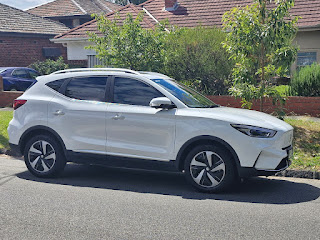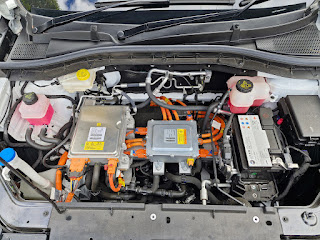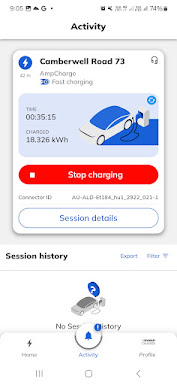Peter Campbell, 19 November 1999
Here is my report of the ride.
The Ride
The longest of rides starts with a click of the pedals. I set off at 8pm on the 1999 Paris Brest Paris audax ride with approximately 800 riders and cycled warily into the night. The first night was to be hell on wheels. I didn't get much sleep the night before.
 |
| Peter Campbell. 1999 Paris Brest Paris |
The motorcycle escort we had for some distance slowed down the peloton, causing much variation of speed. I found the constant braking quite nerve-racking with so many riders around. The fear of an accident was ever present. Unhappily, my fears were confirmed when Oliver Portway fell just behind me after somebody took his front wheel out! Luckily, he was back on his bike immediately without suffering injury or significant damage.
Not long after this, the peloton came to a screeching halt. Initially I thought there had been a huge crash. However, the lead riders had missed one of the "fleches" (arrows) marking a turn-off. The pace slowed briefly, but soon wound up again. Riders spread across the entire width of the road, with many seeking to push through to the front.
Occasionally, an escort motorcycle would force a clear path on the left of the road, causing more bunching up and braking along the huge group. Immediately after this, cyclists would again cover the road width. The occasional car coming the other way had the same effect.
After a cracking hill climb through the streets of Montagne au Perche, I stopped for food and to regain my composure. This was a feed stop on the way out, but it was nice to have a short rest, and let the mad hordes diminish. Back on the bike, a small group formed which gradually grew in size and speed.
The first checkpoint at Villaines la Juhel (220km) took an eternity to reach. After this, we cycled into the "death zone" (3am to 6am), a period I always hate. After nearly dozing off on the bike I trailed off the group in a village, found an open garage, and had a lovely nap for 1 hour (sleep one).
I awoke refreshed, and rode in welcome daylight, feeling good. I passed many riders, then eventually teamed up with a Frenchman to arrive at Fougeres, the second checkpoint. After Fougeres, a peleton formed which travelled at a reasonable speed. I was enjoying the international flavour of the ride by now, as there were no other English speakers in our group, but I was able to converse a little with my limited French.
After Tinteniac, a smaller group consisting of Bernard (French), Harry (Rumanian), Paul (English) and myself teamed up. We worked well together and chatted a lot. Paul was as strong as an ox. As the day progressed, the temperature increased. Our road speed decreased a little, as overheating became a real possibility. A secret control provided a quick rest. The endless aggregations of locals of all ages yelling encouragement along the route kept our spirits up.
Arriving at Loudeac later in the afternoon, I was greeting by the Audax Australia contingent who were rendering excellent assistance and moral support. After getting the brevet signed and eating, I lay back on the grass and shut my eyes for a moment. I woke an hour later (sleep 2). My companions had departed; I felt a bit miffed, but much better after the nap. I teamed up with Phillip - a fellow Australian now resident in Germany. As we rode into the night we passed Paul who had punctured, so my nap did not end up costing me much time.
At Carhaix-Plouguer, the welcome was quite overwhelming; the whole town seemed to be out clapping and cheering. After another good meal, Phillip and I got back on our bikes and rode off into the darkness. At one point I stopped with Phillip for a quick break to overcome a bout of his drowsiness. I noticed a glimmer in the bushes. I shone my headlamp and saw numerous cyclists snoozing in the forest; their reflective vests glittered in my beam.
A sadist must have mapped out the route to Brest; we kept turning away from the Brest signposts, down long gullies and up more climbs. At one point, some local lads had changed the direction of the route marking arrows. We duelled with two Norwegians on a small climb. At last we were rewarded by the glittering lights of Brest and a welcome 3-hour sleep (sleep 3). It was a great psychological boost to reach halfway.
Paul, Phillip & I left Brest cycling into light drizzle early in the morning. The route climbed slowly, thankfully avoiding the heinous gullies of the previous night. Small peletons formed around our nucleus, but we tended to drop most riders on the hills.
We chose a pretty town and stopped at a nice café for coffee and ice-cream. The locals were lunching en masse and relaxing nearby and asked if we would be back in 4 years. I replied "probably not, I prefer a holiday at the beach".
 |
| Bernard Bobillier-Kennot, Peter Campbell & Paul Crib, 1999 Paris Brest Paris |
It was a long day, but a pleasurable one, as we chatted to riders en route, and kept up a good pace. At one point we careered along with a tandem that was really moving. We were hoping to get to Villaines la Juhel for the next sleep, but as the night dragged on fatigue and soreness set in, so we elected to stop at Fougeres for another 3-hour sleep (sleep 4).
This time, Paul & awoke in the dark, but there were no sign of Phillip, and we couldn't locate him among the masses of slumbering bodies. We found out later that the helpers did not wake him. Refreshed after the sleep, Paul and I slotted in with a predominantly French peleton. I chatted amiably with the riders. They were keen to stop and avail themselves of free coffee on offer by friendly locals, so eventually we left them.
Daylight again, then through Villaines la Juhel and Mortagne au Perche checkpoints, with the scenery now forming a blur. I was amazed by some of the descents, as I had no recollection of climbing them on the way out.
At one stage we chased down a large peleton in the distance, hoping for a good sit with them, but Paul rocketed past the group like they were standing still, with me hanging on his wheel. We then teamed up with Jardi, a colourful Spaniard, for a fast run across the plateau leading to Nogent le Roi, with the end of the ride fast becoming a reality.
The final leg had a few sharp climbs, but the scenery was nice. We cranked up the speed a couple of notches when some cyclists coming the other way said (in French) "quick, quick, you might get under 70 hours". Passing the San Quentin en Yvelines sign gave us false hope, as the 70-hour mark ticked over while we continued on what seemed like interminable circuits of the district.
Near the end, we met a motorcycle escort, who led us the final distance through the traffic in fine style. Arriving at the roundabout was a sensational feeling. Paul & I dismounted and shook hands warmly.
After handing in our brevets, we sat on the grass outside for an unforgettable rest. It was a great to tear off the gloves and rub my hands, knowing I was not going to get on the bike again in a hurry. The grass was wonderful.
I had taken 70.5 hours, 45 hours on the bike, 8 hours sleeping and the rest eating.
 |
| Peter Campbell & Paul Crib, 1999 Paris Brest Paris |
Three years of preparation and a solid year of training had culminated in a great ride with great companions. The support, encouragement and advice of numerous fellow Audax riders, family and friends made it all possible. Memories of the adventure, camaraderie, and scenery will stay with me for the rest of my life.
Ride stats
The first riders in were Christophe BOCQUET & Philippe DEPLAIX with a ride time 44:22
Post script
2 weeks after the PBP, Lena & I started our official honeymoon, and cycle toured through Burgundy, the Dauphine and Provence. We covered 1300km in 4 weeks, but that is another story.
Gear & Clothing
I took a full set of clothing, but no spares or changes. I used my lightweight Gamex Audax top once and leg warmers twice. I did not use my long gloves, my rain jacket or my warm headband.
I saved 500g by taking a compact Ultimate bladder/backpack, over a pack rack and rack bag. This gave me the option of carrying water on my back and reserving my two water bottles for Coke, Orangina, sports drink and the like. The backpack was very comfortable and did not bother me during the ride. It also had the advantage of keeping my stuff with me at checkpoints.
I chose to avoid the added logistics of arranging a bag drop for additional clothing and/or equipment.
Repairs
I was assisted with a couple of minor running repairs and adjustments at checkpoints; the workshops were well equipped and staffed for all hours. I left a small tip. I did not end up using my small kit of tyre levers, patches and Allen keys. If your bike is in good shape, you should have no problems.
Lights
After seemingly endless consideration and discussion of options and calculation of battery life, I elected to take 2 Cateye Micros and a homemade battery pack of 4C and 4D cells (hot swappable via plugs). While this weighed a lot, it did guarantee me getting through the night. I also used a 10W Niterider Headlamp with a lightweight NiMh cell which proved to invaluable for fast descents and spotting route markers. Its 2.5 hour burn time got me through both nights as I used it sparingly. I carried spare AAs for the Cateye lights.
Food
Tasty and nutritious food with good energy
value was available at all checkpoints.
Soup, pasta, salads, meat dishes, fruit and deserts were all
available. I carried 20 Leppins and
finished the ride with 2 left. You
really only need to carry food and drink to get you between checkpoints and
avoid "cracking". Food bars
were sparingly available, but bananas were common. Sports drink was hard to get, and tasted
foul.
Hygiene & Health
I adopted the "irrigation by constant application" technique, as advocated by Malcolm Rogers, to maintain comfort for the nether region. I kept applying small quantities of anti fungal and silicon creams to chafing and pressure points. This worked well for me; I did not suffer much discomfort. Mind you, Avocet O2 saddles are wonderful. I also used silicone cream on my hands to prevent softening due to sweat.
If you feel the need for a rear end overhaul, there are chemist shops and supermarkets en route and the Red Cross can assist at checkpoints with ointments such as nappy cream. Some fellow riders bought lignocaine cream to deaden the pain, but this should be a last resort as more damage to numb areas is likely.
I had blocked sweat glands (red spots) on my feet, armpits and chamois region; these cleared up quickly after the ride.
The biggest problem I had was numbness in some toes of my left foot, which 3 months after the ride has not completely gone yet. This was a new problem, and
there was little I could do to prevent it.
My Time pedals and shoes were high quality.
Some Do's
- Take your own energy food supplements (e.g. Leppins), there are limited options available in France.
- Use a good headlamp; they are excellent for descents. The brighter the better.
- Aim for redundancy with your lights so you can swap parts if something fails.
- Sleep or stop when you are really tired; falling asleep and crashing might be the end of your ride, or you.
- Aim to build up a time buffer so that you have some contingency if things go wrong.
- Do your own ride, if you ride faster than you are comfortable with you risk blowing up. Riding slower than your optimum can be frustrating. There are plenty of people to ride with.
- Stand out of the saddle frequently to relieve pressure points and vary muscle groups.
- Use a light rain jacket (rather than a heavier Goretex one); they are good for both shower proofing and for added warmth at night.
- A layer of foam under the handlebar cork wrap helps prevent pressure points (or use double cork).
Some Don'ts
- Don't use SPD pedals; use a flatter road pedal/shoe combination such as the Look or Time systems. The flatter pressure surface is less likely to cause nerve problems with the soles of your feet.
- Don't do the 80 hour start unless you are either brave or foolish.
- Don't carry nappy wipes. I read somewhere they were recommended, but they are bulky, heavy and unnecessary. If you really need some (you probably won't) then buy them en route.
- Don't carry too many heavy batteries; you can buy them at checkpoints.
- Don't avoid the Red Cross and medical assistance on the ride if you have a serious medical problem, you risk permanent injury if you do so.
- Don’t carry a full medical or tool kit or too much clothing; too much stuff will weigh you down and make injuries and/or mechanical problems more likely, and make the ride much harder.
























